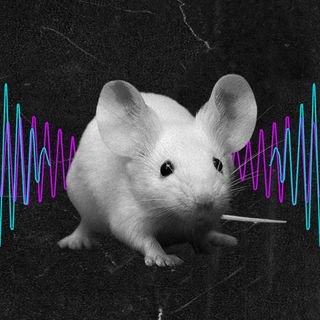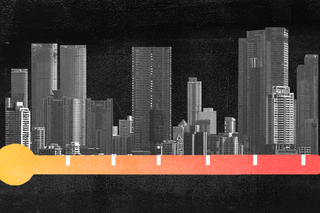
India’s Heatwaves Are Proving Fatal. ‘Wet Bulb Temperature’ Can Help Explain Why
The temperature is a more meaningful way to understand the complexity of climate change, and when our cities will become uninhabitable.

India is getting too hot too early, and our thermalmaps tell this sweltering story. Textures of red, orange, and yellow tell worrying tales; temperatures soar beyond the 40-degree mark in different parts. India’s deadly heatwaves, which have killed thousands of people and impacted livelihoods over the years, have come in too early this year. March 2022 was the hottest March that India has witnessed in 122 years, according to the Indian Meteorological Department.
These are arguably record-breaking times. But that is a very superficial lens to understanding how critically climate change is threatening lives, livelihoods, health, social issues, and cities. When do high temperatures become dangerous? Which places, in particular, are more vulnerable to these natural hazards? The full story lies in understanding how heat becomes lethal — and when things will get from “unbearable” to “unhabitable.”
This is where the concept of “wet bulb temperature” comes in. This temperature is a scientific measure of heat and humidity. Why humidity? Because even rising humidity (which a 2017 study showed), when combined with heat, takes a toll on human health. And these conditions are happening much earlier than anticipated.
Which brings us back to the wet bulb. In the most literal sense, it refers to the temperature that a wet thermometer will show in the shade, as water evaporates from it. The number that it reflects then reveals a dichotomy. The wet bulb temperature is the lowest temperature an object can reach in a hotter environment — while it cools down as the water evaporates from the surface. These wet bulb conditions occur when the heat and humidity are both too high for sweat to evaporate off the body.
“The usefulness of wet bulb temperature is it makes it clear how close conditions are to becoming lethal. The closer wet bulb temperature gets to our body temperature, the less heat is lost, and the closer we are to heat death,” as Peter W. Reiners explained in Salon. Lower wet bulb temperatures — somewhere between 29°C and 31°C — can also cause deaths, according to a 2017 study.
“If the wet bulb temperature exceeds the human body’s skin temperature of around 35°C, perspiration can no longer act as a cooling mechanism and the body will quickly overheat, which can result in death.”
A quick biology lesson here is our bodies, much like engines, need to lose heat in order to do the work — or else they will overheat and stop functioning. We lose this heat when sweat evaporates, and this process still happens when our surroundings are warmer than our bodies. Humidity, naturally, interferes with this process, as moisture in the air increases and disrupts the cooling effect that evaporation would have otherwise offered.
Related on The Swaddle:
Deadly Heatwaves Will Be the Norm in India by 2040: Report
One study has already found that the maximum wet bulb temperatures in parts of the Central Americas, North Africa, the Middle East, Northwestern and Southeastern India, and Southeast Asia have already approached or crossed the 35º C threshold.
So while extreme temperatures and record numbers vie to get our attention, it is the story humidity tells that is of immediate notice.
Another story the wet bulb temperature tells is which regions are more vulnerable to heat stress. India’s east coast will have higher temperatures than the west because of humidity.
Until 2010, the understanding was such values will remain much later in the future. Even the 2017 study noted that “Wet Bulb Temperatures approaching 35°C almost never occur in the current climate, and thus there is little real-world data on human health outcomes.” But that is no longer the case. Recent heatwaves have killed thousands of people — and these are not circumstances we can just adapt to.
“These are not mere numbers: locked away in their values is one that connects directly to human biology, public health, and governance in the era of the climate crisis,” Vasudevan Mukunth wrote in Wire Science.
Related on The Swaddle:
India Has Three New Heatwave Hotspots, Raising Mortality Risks
The wet bulb temperature gives texture to understanding heat stress. It highlights the complexities of global warming and predicts the conditions that may, or may not, be habitable for humans. Moreover, it also paints a truer picture of the number of people who succumb to heatwaves every year. According to government statistics, almost 17,000 people have died in the last 50 years; between 1992 and 2015, different states recorded deaths between 400 to 3,000 every year. But experts caution a more vivid, true account of deaths is still hidden.
“India’s reported numbers of heatwave deaths is often just the tip of the iceberg,” Dr. Dileep Mavalankar, Director at the Gandhinagar-based Indian Institute of Public Health told The Bastion. “About 10% of the actual heat-related deaths get reported as due to heatstroke, while about 90% are not visibly reported.” He adds that “If we have correct data of reported deaths, we will be able to communicate these trends strongly to the people and give nuanced advice depending upon the type of heatwave, its time, and duration of occurrence.”
This makes sense; only when we understand the scale of the crisis in human terms, will our response to it be altered to urgency. “If the effect of wet bulb temperatures is taken into account, the impact is likely to be larger and more serious,” IndiaSpend also reported in 2018.
The shift in focus on how we understand heat waves will then impact infrastructure and policy action too. The current heat action plans across states will then account for both heat and humidity; experts have also noted the need to come up with a framework that supports people most vulnerable to the crushing heat.
“It is unfortunate that wet bulb temperature is not an everyday concept,” Reiners added, “as it is much more meaningful for understanding human heat stress both from climate change as well as everyday dangers on hot summer days.”
Saumya Kalia is an Associate Editor at The Swaddle. Her journalism and writing explore issues of social justice, digital sub-cultures, media ecosystem, literature, and memory as they cut across socio-cultural periods. You can reach her at @Saumya_Kalia.
Related


Blockchain Ideology Is Rooted in Exclusion. A Feminist Lens Shows Why
